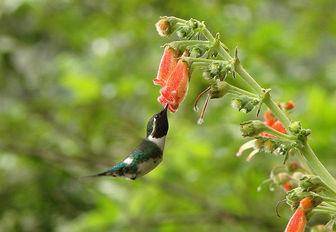Esmeraldas Woodstar
The Esmeraldas Woodstar, Colibri De Berlepsch, ColibrÍ De Esmeraldas, or Estrellita EsmeraldeÑA is a species of hummingbird in the Trochilidae family. It is found only in Ecuador.

Original source: Bert Harris Original uploader was Bertdichrozona at en.wikipediaPermission(Reusing this file)CC-BY-SA-3.0; Released under the GNU Free Documentation License.
Author: Bert Harris Original uploader was Bertdichrozona at en.wikipediaPermission(Reusing this file)CC-BY-SA-3.0; Released under the GNU Free Documentation License.
Permission: GNU Free Documentation License
The Esmeraldas Woodstar is classified as Endangered (EN), considered to be facing a very high risk of extinction in the wild.
Esmeraldas Woodstar Courtesy of Murray Cooper With its striking colors and straight black bill, this 3-inch hummingbird makes up in vividness what it lacks in size - and recognition. Considered rare and uncommon, the Esmeraldas woodstar, whose call is a rapid-fire chit-cheet and chit-chit-cheet, became "range restricted" to two or three disjointed sites in western Ecuador, on the western slope of the Andes. More
Esmeraldas Woodstar Chaetocercus berlepschi in the Chongón-Colonche Hills, western Ecuador. Cotinga 27:38–41. 3. ^ BirdLife International. 2008. Species factsheet: Chaetocercus berlepschi. BirdLife International, Cambridge, United Kingdom. www.birdlife.org/datazone/ External links - * BirdLife Species Factsheet. Stub icon This Apodiformes-related article is a stub. You can help Wikipedia by expanding it. More
“In spite of these recent advances, the Esmeraldas Woodstar remains an elusive species,” said David Wiedenfeld, American Bird Conservancy’s Assistant Director of International Programs. “Most birds leave their breeding grounds after the nesting season is over, but it is still not fully understood where all of them go. Some may move higher into the mountains along the coast, or they may move inland to other forested areas. Future research may provide answers to this question, helping to advance conservation efforts for this diminutive bird. More
the endangered Esmeraldas Woodstar from Ecuador accepted for publication. 15 November 2009- Ecuadorian breeding biology paper accepted for publication. 15 August 2009- Esmeraldas Woodstar research featured on ABC news (USA). 2 March 2009-Description of female Esmeraldas Woodstar selected as lead article for June issue of the Wilson Journal of Ornithology. Read more Esmeraldas Woodstar news from the American Bird Conservancy and the World Land Trust. New WLT story here (27 September). More
The Esmeraldas woodstar, a hummingbird endemic to Ecuador, is a mysterious, range-restricted, forest-dwelling species with highly localized populations. Locally known asolibrí de Esmeraldas or estrellita esmeraldeña, this hummingbird is tiny, with striking violet, green, and white plumage. Little is known about this secretive species, as it seems to disappear from known locations during nonbreeding months, but its preferred evergreen forest environment is one of the most threatened forest habitats in the Neotropics. More
The Esmeraldas Woodstar is one of these. It breeds in the Colonche Hills of western Ecuador, and with out the preservation of its habitat and the flowering plants it requires for survival, it and many other animals are doomed with extinction. HMN is teaming up with Dr. Becker and the community of Loma Alta to expand the protection of the fog forest. Dr. C. Dusti Becker has been working in the Tumbesian region of southwestern Ecuador for the past decade. More
fantastic little Esmeraldas Woodstar in Ayampe. A couple of other hummers were also worthy of note, also having tiny ranges - the endemic Violet-throated Metaltail that we saw close to the edge of the paramo in El Cajas, and the scarce burgundy-throated Neblina Metaltail up in the mist on the Cerro Toledo Road. Of course no tour to the south would be complete without Ecuador's most famous bird, the Jocotoco Antpitta. More
Esmeraldas Woodstar (EN) (Chaetocercus berlepschi) - At least two males seen on the same dead sapling at Ayampe where I first saw them over two years prior. Endemic to Ecuador. TROGONS AND QUETZALS (Trogonidae) Golden-headed Quetzal (Pharomachrus auriceps) (H) Ecuadorian (Black-tailed) Trogon (Trogon mesurus) - A contentious split of Black-tailed Trogon, a Tumbesian endemic. More
Esmeraldas Woodstar (Chaetocercus berlepschi) thanks to the support of the World Land Trust-US and American Bird Conservancy. This tiny hummingbird, barely bigger than a bumblebee, is endemic to moist forest in the coastal lowlands and foothills of central and northern Ecuador, where it has a small range and an extremely fragmented distribution. Although the Fundación Jocotoco researchers encountered the hummingbird most frequently in the Ayampe area, they also found small numbers at sites as far as 62 miles northward along the coast. More
Family : Trochilidae
Genus : Chaetocercus
Species : berlepschi
Authority : Simon, 1889

